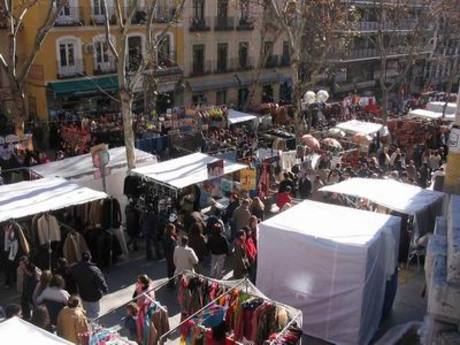The Rastro Flea Market
Madrid's largest open air flea market, "El Rastro" is held from 9am to 3pm in the historic center of Madrid every Sunday, and also on public holidays, attracting as many locals as tourists, and offering a variety of products both new and old.
El Rastro means "the trail". The market probably owes its name to the tanneries that were once located in Ribera de Curtidores (Ribera de Curtidores means 'riverside of tanners'). Close by, on the banks of the Manzanares River, was an abattoir. Transporting the slaughtered cattle from the abattoir to the tannery left a trail (rastro) of blood along the street. An alternative etymology suggests el Rastro once meant “outside”, referring to the fact el Rastro was once outside the jurisdiction of the mayor’s court.
Said to be the largest flea market in Europe with up to 3500 different stalls, it extends through several streets in one of the city's oldest working-class neighborhoods. Established in the Middle Ages, its hub is the Plaza de Cascorro (featuring a statue of legendary soldier Eloy Gonzalo) and sprawls downhill towards the river. The main street is Calle Ribera de Curtidores, formerly the site of the city's tanning industry.
There are bargains in everything from furniture to clothing, together with souvenirs and a wide range of other goods. Antique shops also line the surrounding streets and remain open on Sundays to take advantage of the market's lively crowds and wonderful atmosphere.
El Rastro is a series of winding streets passing though what is the oldest residential part of Madrid and this network of randomly networked streets contain the market. Although there is a main street dedicated to Market stalls (predominately clothing) the side streets contain the real treasures.
Starting at either Metro La Latina or Plaza Mayor follow the crowds heading downhill towards Puerta de Toledo (you cannot see the Puerta so follow the signs). Within 50m & 200m respectively you will find yourself shoulder to shoulder with what appears to be half of Madrid. Everyone enters for the main thoroughfare but you will quickly end up in one of the side streets as you continuously catch something from the corner of your eye that has to be "checked out".
The rastro market takes up a large triangular area, outlined by Toledo, Embajadores and Ronda de Toledo streets. The market center is located in the Plaza de Cascorro. The closest subway stations are La Latina y Puerta de Toledo.
On Calle Ribera de Curtidores one can find handicrafts, hand-stitched clothing and antiques. On Calle San Cayetano, known as the painters’ street, there are stands selling paintings and replicas of works of art. There are also many art stores that stay open during the week. In the Plaza del General Vara del Rey there are mostly second hand clothes and furniture stands. On Calle Rodas there are mostly antiques. The Campillo terrace offers practically anything: tools, fabrics, leather, music, and old magazines.
If you're in the city between 9am and 3pm on Sundays or public holidays, this is an experience not to be missed (although you should look out for your belongings, as this is a place notorious for pickpockets).
A large part of the El rastro experience is not the shopping but the stopping at small bars and enjoying a Caña and Tapa (small beer with a portion of food). These are crowded and noisy as if the market has entered the bar! Madrid guide Spain recommends you try the "Taberna Andaluz" for fresh seafood although you will have to find it first.
If you are thinking of taking lunch, it is recommended to leave El Rastro and return afterwards. However, if you are happy with half a baguette and a can of fizzy drink, these can be obtained and eaten on the move for less than 3€. You can get there via flight to Madrid.




